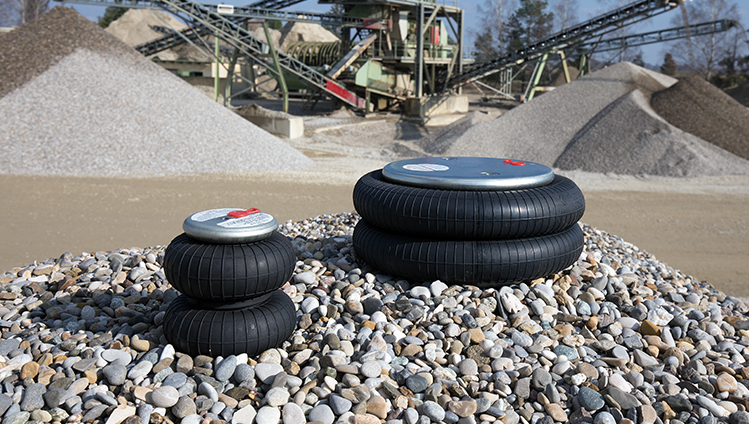 For decades, air springs have been reliable components in industrial applications: They carry massive loads and reliably perform lifting operations. They are also highly effective when it comes to insulating vibrations in tractors and combine harvesters, as well as commercial vehicles in the construction industry. By making air springs "smart", Continental is now showing that these fairly inconspicuous components have massive potential for digitalization.
For decades, air springs have been reliable components in industrial applications: They carry massive loads and reliably perform lifting operations. They are also highly effective when it comes to insulating vibrations in tractors and combine harvesters, as well as commercial vehicles in the construction industry. By making air springs "smart", Continental is now showing that these fairly inconspicuous components have massive potential for digitalization.
The brains of the air spring: The HPTA sensor
This is made possible by the HPTA sensor, which Continental offers for many standard air springs. The abbreviation "HPTA" describes the physical variables that the sensor can detect: Height, Pressure, Temperature and Acceleration. This status information is enormously valuable for users, because it opens the door to the almost limitless possibilities offered by digitalization.
HPTA sensor provides invaluable operating data
 Sensor data is a basic requirement for many active and passive applications. The height signal, for example, is an important control variable for active and load-independent level control. For example, it enables the height of a field sprayer to be optimally adjusted and actively controlled during operation. This optimizes the use of fertilizers. In addition, all data can be recorded and evaluated as part of continuous condition monitoring. If, for instance, the height of the air spring in industrial applications regularly deviates from the set value at constant load, this indicates a compressed air leakage in the system. This is hardly noticeable, but leads to unnecessary consumption of compressed air and energy. The other measured variables can also be provided with alarm thresholds, so that deviations from normal operation are detected immediately. In this way, malfunctions can be detected before they happen, avoiding unplanned downtimes and reducing maintenance costs. The measurement values provided by the sensors can be used to calculate other variables such as oscillation amplitudes, vibration frequencies or the weight on the air spring. "All this information helps companies to operate their installations safely and efficiently," says Manuel Mosich, who is responsible for the development of the HPTA sensor for industrial air springs at Continental, adding "With integrated sensor technology we give our customers the opportunity to digitally map their processes in order to make them future-proof."
Sensor data is a basic requirement for many active and passive applications. The height signal, for example, is an important control variable for active and load-independent level control. For example, it enables the height of a field sprayer to be optimally adjusted and actively controlled during operation. This optimizes the use of fertilizers. In addition, all data can be recorded and evaluated as part of continuous condition monitoring. If, for instance, the height of the air spring in industrial applications regularly deviates from the set value at constant load, this indicates a compressed air leakage in the system. This is hardly noticeable, but leads to unnecessary consumption of compressed air and energy. The other measured variables can also be provided with alarm thresholds, so that deviations from normal operation are detected immediately. In this way, malfunctions can be detected before they happen, avoiding unplanned downtimes and reducing maintenance costs. The measurement values provided by the sensors can be used to calculate other variables such as oscillation amplitudes, vibration frequencies or the weight on the air spring. "All this information helps companies to operate their installations safely and efficiently," says Manuel Mosich, who is responsible for the development of the HPTA sensor for industrial air springs at Continental, adding "With integrated sensor technology we give our customers the opportunity to digitally map their processes in order to make them future-proof."
 With the HPTA starter kit you can learn more about this innovative technology and the advantages which air springs with integrated sensor technology offer. In addition to an air spring with a sensor, the starter kit case also contains a USB adapter and software with instructions. As a result users can test all the sensor functions and try them out directly on their own systems in their own environment, in order to experience the added value which is provided in practical operation. In addition, as part of development projects, Continental offers technical support for the design of the air springs and the integration of the sensors in the relevant application.
With the HPTA starter kit you can learn more about this innovative technology and the advantages which air springs with integrated sensor technology offer. In addition to an air spring with a sensor, the starter kit case also contains a USB adapter and software with instructions. As a result users can test all the sensor functions and try them out directly on their own systems in their own environment, in order to experience the added value which is provided in practical operation. In addition, as part of development projects, Continental offers technical support for the design of the air springs and the integration of the sensors in the relevant application.
C+ Technologies
Its "Integrated Sensor Technology" featuring the HPTA sensor is part of Continental's technology offensive. Under the title of "C+ Technologies" the company is developing new solutions for future air spring applications in the industrial sector. These include reduced bellows volumes to increase energy efficiency and sustainability, special materials for greater safety, and smart Big Data applications that make sensor-based data collection more effective. For this purpose, Continental takes full advantage of the synergies provided within its corporate group, in particular in terms of production materials and material development as well as inspection and testing facilities.